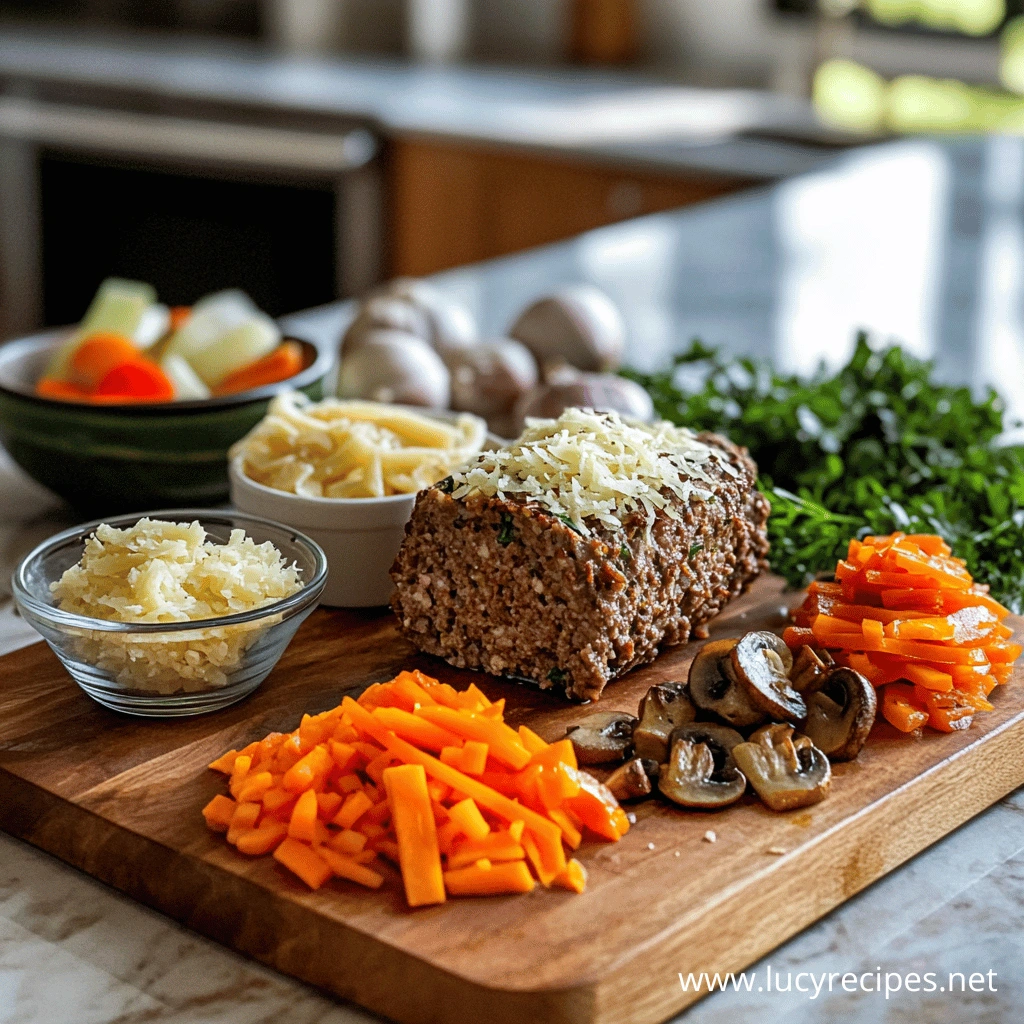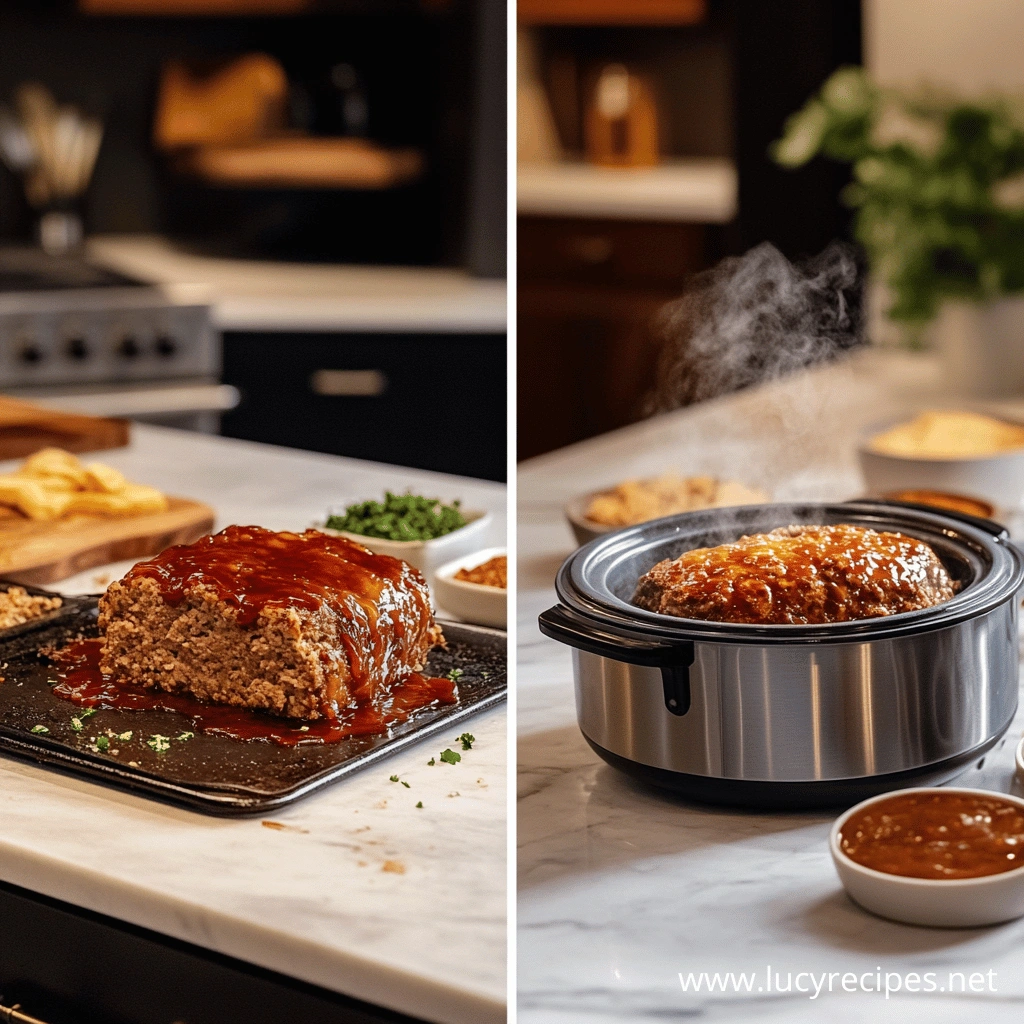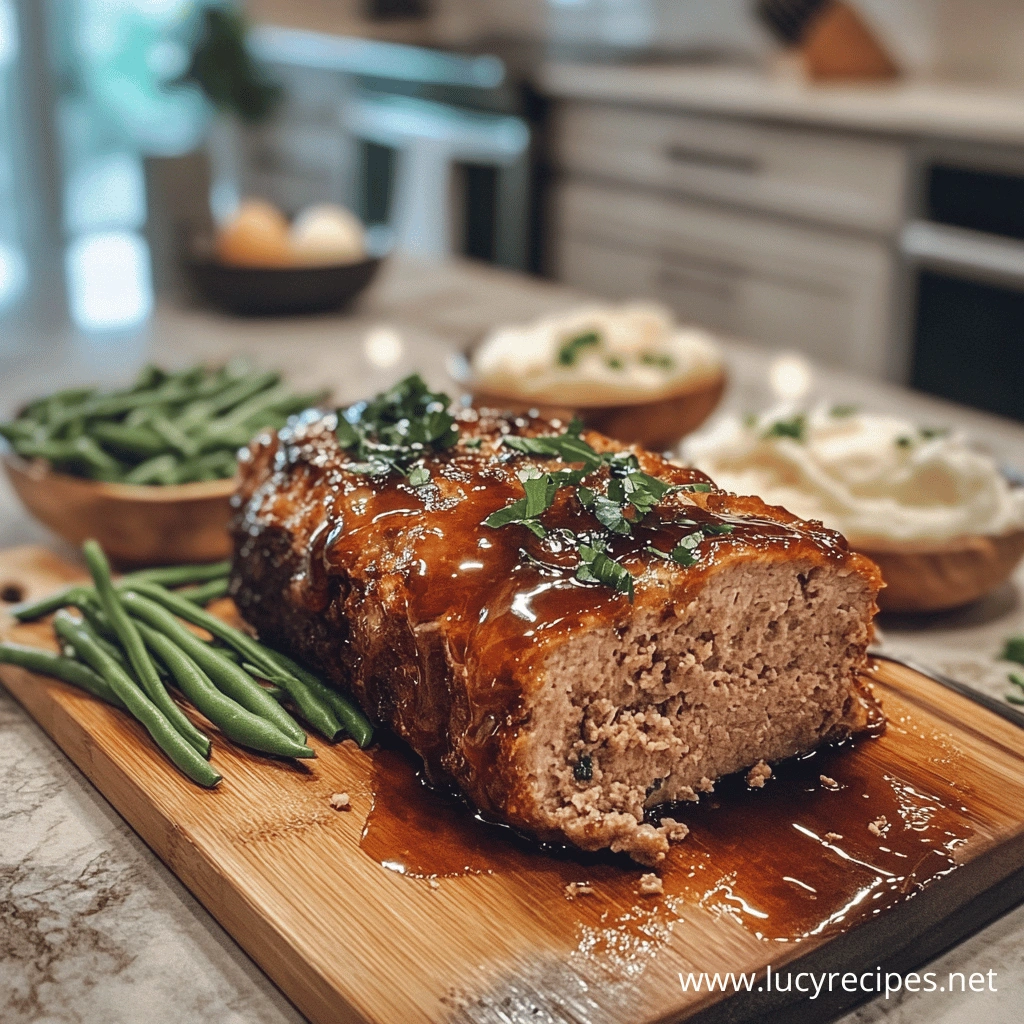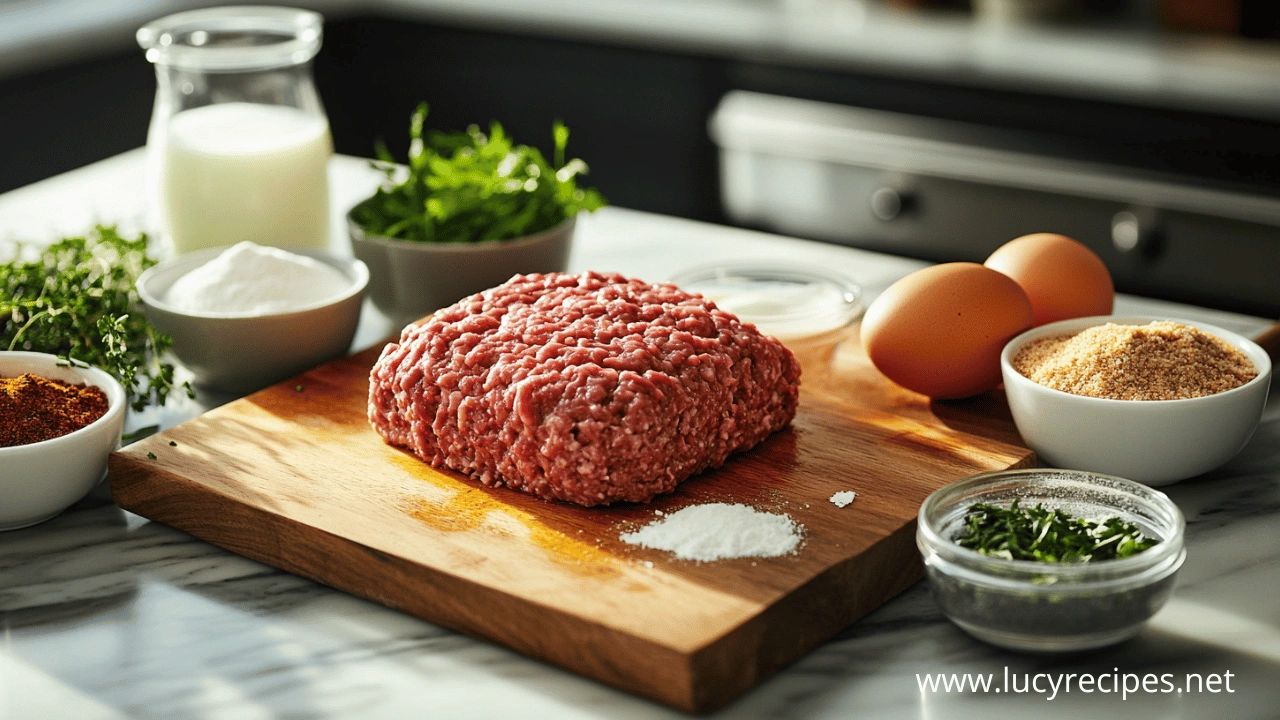Introduction: What Ingredients Are in Meatloaf?
Meatloaf is a classic comfort food that brings families together around the dinner table. This hearty dish is known for its rich flavor, tender texture, and the perfect balance of savory seasonings. But what exactly goes into making a great meatloaf? While recipes may vary based on tradition, personal taste, or regional influences, most meatloaves share a few essential ingredients that create the perfect blend of moisture, flavor, and structure.
From the choice of ground meat to the binding ingredients that hold it all together, each component plays a crucial role in achieving the ideal texture and taste. Whether you’re looking for a traditional meatloaf recipe or want to experiment with different flavors, understanding these key ingredients will help you make a delicious, home-cooked meal. Let’s break down the must-have ingredients that make meatloaf a timeless favorite.
Table of Contents
Main Ingredients
Meatloaf is a simple yet flavorful dish made with a combination of essential ingredients that work together to create the perfect texture and taste. Whether you prefer a traditional recipe or like to add your own twist, understanding the role of each ingredient will help you make the best meatloaf possible.
Ground Meat: The Foundation of Meatloaf
The heart of any meatloaf is the ground meat. Traditional recipes often use ground beef, but many cooks mix different meats like pork, veal, or turkey to enhance flavor and texture. A blend of 80/20 ground beef (80% lean, 20% fat) is ideal for keeping the meatloaf juicy and tender. Leaner meats, like turkey or chicken, can be used for a healthier option, but they may require additional moisture to prevent dryness. Learn more about the Secret to Moist Meatloaf to ensure your dish stays tender and flavorful.
Binding Agents: Eggs and Breadcrumbs
Eggs and breadcrumbs are essential for holding the meatloaf together. The eggs act as a binding agent, helping to keep the mixture firm yet tender. Breadcrumbs (or alternatives like crushed crackers or oats) absorb moisture and give the meatloaf structure, preventing it from falling apart while cooking. For a gluten-free option, almond flour or crushed gluten-free crackers work just as well.
Liquid Ingredients: Milk, Broth, and Alternatives
Adding liquid to meatloaf helps maintain moisture and prevents it from becoming too dense. Milk is a common choice, as it softens the breadcrumbs and blends well with the meat mixture. For a dairy-free alternative, you can use beef broth, chicken broth, or even plant-based milk. Some recipes incorporate tomato sauce or Worcestershire sauce for extra depth of flavor.
Seasonings and Spices: Flavor Enhancers
Seasonings bring the meatloaf to life, elevating its overall taste. A basic meatloaf typically includes salt, black pepper, garlic powder, and onion powder. Some recipes call for fresh herbs like parsley or thyme for a more aromatic touch. Worcestershire sauce, mustard, or a dash of hot sauce can add complexity and a hint of tanginess. For a slightly sweet balance, a ketchup or brown sugar glaze on top is a classic finishing touch.
By combining these key ingredients in the right proportions, you can create a delicious and satisfying meatloaf that’s packed with flavor and perfectly moist.
Additional Ingredients for Moisture and Texture

Beyond the basic components, certain ingredients can enhance the flavor, moisture, and texture of meatloaf. These additions not only make the dish more delicious but also add a unique twist to classic recipes.
Vegetables: Onions, Garlic, and More
Vegetables play a key role in boosting the moisture and depth of flavor in meatloaf. Onions are a staple ingredient, providing natural sweetness and a slight crunch when finely chopped. Garlic adds a rich, savory taste that complements the meat perfectly. Other great additions include bell peppers for a subtle sweetness, carrots for extra moisture, and mushrooms for an umami boost. To ensure even cooking, it’s best to sauté these vegetables before mixing them into the meatloaf.
Cheese: Adding Creaminess and Richness
Cheese is a fantastic way to enhance the richness of meatloaf. Adding shredded cheddar, mozzarella, or Parmesan to the mixture provides extra creaminess and a deliciously melty texture. Some recipes even feature a cheese-stuffed center for an indulgent surprise. If you prefer a sharper, tangier taste, crumbled feta or blue cheese can add a bold flavor. No matter which cheese you choose, it brings an irresistible depth to this classic dish.
By incorporating vegetables and cheese, you can elevate your meatloaf, making it even more flavorful, moist, and satisfying.
Optional Flavor Enhancers
If you want to take your meatloaf to the next level, adding bold flavor enhancers can make all the difference. These ingredients bring depth, tanginess, and a touch of umami, making your meatloaf even more delicious.
Worcestershire Sauce and Soy Sauce
Worcestershire sauce is a classic addition to meatloaf, providing a deep, savory, and slightly tangy flavor. Its blend of vinegar, molasses, and spices enhances the meat’s natural richness. Similarly, soy sauce adds a salty, umami-packed boost, making the meatloaf even more flavorful. For a more complex taste, try using a combination of both sauces or opt for tamari as a gluten-free alternative.
Mustard and Tomato-Based Additions
Mustard, whether yellow, Dijon, or spicy brown, adds a hint of tang and heat that balances the richness of the meat. Many meatloaf recipes also feature tomato-based ingredients like ketchup, tomato paste, or even barbecue sauce. These ingredients not only contribute a slight sweetness but also help keep the meatloaf moist. A layer of ketchup or barbecue sauce on top creates a delicious caramelized glaze while baking, adding both flavor and a beautiful finish.
Experimenting with these optional ingredients allows you to customize your meatloaf to your taste, making each bite packed with bold, mouthwatering flavors.
Glazing and Toppings
A well-made glaze is the perfect finishing touch for meatloaf, adding both flavor and an appealing caramelized crust. Whether you prefer a traditional sweet-and-tangy topping or something with a deeper richness, the right glaze can elevate your meatloaf from good to unforgettable.
Classic Ketchup Glaze
The most iconic meatloaf topping is a ketchup-based glaze. A simple mixture of ketchup, a splash of vinegar, and a hint of brown sugar creates a slightly tangy, slightly sweet coating that caramelizes beautifully in the oven. Some recipes also add Worcestershire sauce or mustard for extra depth. Brushing this glaze over the meatloaf before baking ensures a flavorful, slightly sticky topping that enhances every bite.
Brown Sugar and Honey Variations
For those who enjoy a sweeter glaze, brown sugar and honey are excellent alternatives. Mixing brown sugar with Dijon mustard and apple cider vinegar creates a well-balanced glaze with a touch of tang. Honey or maple syrup can be used instead of sugar for a natural sweetness. Some cooks even incorporate barbecue sauce for a smoky, slightly spicy kick. These variations bring a rich, glossy finish that pairs perfectly with the savory meatloaf.
Choosing the right glaze or topping allows you to customize your meatloaf’s flavor profile, ensuring a delicious and visually appealing result every time.
Cooking Techniques

Once you’ve gathered the perfect ingredients for your meatloaf, the next step is choosing the best cooking method. While baking is the traditional approach, slow cooking offers an alternative for a tender, moist result. Each method has its own benefits, depending on your desired texture and flavor.
Baking vs. Slow Cooking: Which Method is Best?
Baking is the most common way to cook meatloaf, providing a firm texture with a slightly crispy outer crust. Typically, the meatloaf is shaped into a loaf and baked in a loaf pan or on a baking sheet at around 350°F for about an hour. Baking allows the glaze to caramelize beautifully, creating a flavorful topping while locking in moisture.
Slow cooking, on the other hand, results in an incredibly tender and juicy meatloaf. Cooking it in a slow cooker for 4–6 hours on low ensures that the meat absorbs flavors and remains moist without drying out. This method is ideal for those who prefer a softer texture or want a more hands-off approach to cooking.
Both methods produce delicious results, so the best choice depends on your preference. If you love a crispy exterior and shorter cooking time, baking is the way to go. If you want extra-juicy meatloaf with minimal effort, slow cooking is a great alternative.
For more expert cooking methods, check out the Ultimate Meatloaf Guide, which covers alternative techniques to perfect your meatloaf.
Alternative Meatloaf Recipes
Meatloaf doesn’t have to be made with traditional ground beef. Whether you’re looking for a leaner option or a completely plant-based alternative, there are plenty of creative ways to enjoy this classic dish.
Turkey and Chicken Meatloaf Variations
For a lighter take on meatloaf, ground turkey or chicken are excellent substitutes for beef. These lean meats create a healthier version while still maintaining great flavor. Because turkey and chicken have less fat than beef, it’s important to add moisture-rich ingredients like sautéed onions, shredded zucchini, or a bit of olive oil. Using a mix of dark and white meat can also help prevent dryness. Spices like garlic powder, paprika, and Italian seasoning can enhance the flavor, while a classic ketchup or barbecue glaze keeps it juicy and delicious.
Vegan and Vegetarian Meatloaf Substitutes
For a meat-free alternative, plant-based ingredients can mimic the texture and taste of traditional meatloaf. Lentils, chickpeas, black beans, or mushrooms serve as hearty bases, while oats or breadcrumbs help bind everything together. Mashed sweet potatoes or flaxseed mixed with water can replace eggs, ensuring the loaf holds its shape. Seasoning is key in vegetarian versions—ingredients like smoked paprika, soy sauce, and nutritional yeast add depth and richness. Topping it with a tomato-based glaze completes the dish, making it just as satisfying as the classic version.
Whether you’re looking for a leaner protein option or a fully plant-based meal, these alternative meatloaf recipes prove that there’s a delicious version for everyone.
Expert Tips and Tricks

Making the perfect meatloaf is all about balancing moisture, texture, and flavor. Whether you’re a beginner or a seasoned cook, these expert tips will help you achieve a tender, juicy, and flavorful meatloaf every time.
How to Keep Meatloaf Moist and Flavorful
One of the biggest challenges in making meatloaf is preventing it from drying out. Here are a few key ways to keep it moist and delicious:
- Use the right meat ratio – A mix of 80/20 ground beef (or a combination of beef, pork, or veal) ensures enough fat for moisture without being too greasy.
- Add moisture-rich ingredients – Finely chopped onions, grated carrots, or mushrooms contribute extra moisture while enhancing flavor.
- Don’t skip the binders – Eggs and breadcrumbs help hold everything together while keeping the meatloaf from becoming too dense. Soaked breadcrumbs (in milk or broth) provide even better texture.
- Avoid overmixing – Gently combine the ingredients to prevent the meat from becoming tough. Overmixing compacts the meat, leading to a dry, rubbery texture.
- Use a glaze – A ketchup, barbecue, or brown sugar glaze locks in moisture while adding a deliciously caramelized topping.
Common Mistakes to Avoid
Even a simple recipe like meatloaf can go wrong if you’re not careful. Avoid these common pitfalls:
- Skipping the resting time – Let the meatloaf rest for about 10 minutes after baking. This helps redistribute juices, keeping it tender and preventing it from falling apart when sliced.
- Cooking it in a loaf pan – While a loaf pan helps retain shape, it can also trap grease, making the meatloaf soggy. Try shaping it free-form on a baking sheet for better texture.
- Not seasoning enough – Meatloaf needs bold flavors. Be generous with seasonings like salt, pepper, garlic powder, and Worcestershire sauce. Under-seasoned meatloaf can taste bland.
- Overcooking – Using a meat thermometer ensures perfect doneness. Cook until the internal temperature reaches 160°F (for beef) or 165°F (for poultry). Overcooked meatloaf turns dry and crumbly.
By following these tips and avoiding common mistakes, you can make a meatloaf that’s moist, flavorful, and satisfying every time!
FAQs
What ingredients are essential for a classic meatloaf?
A traditional meatloaf typically includes ground beef (or a mix of meats), eggs, breadcrumbs, milk or broth, seasonings (salt, pepper, garlic powder, onion powder), and a glaze made from ketchup or barbecue sauce. These ingredients work together to create a flavorful, moist, and well-structured meatloaf.
Can I make meatloaf without breadcrumbs?
Yes! If you want to skip breadcrumbs, you can use crushed crackers, rolled oats, almond flour, or even cooked rice as a binding agent. These alternatives help hold the meatloaf together while maintaining texture.
How do I keep my meatloaf from falling apart?
Ensuring your meatloaf has the right balance of binding agents (like eggs and breadcrumbs) is key. Also, avoid overmixing the meat mixture, as this can lead to a crumbly texture. Letting the meatloaf rest after baking helps it hold its shape when sliced.
What’s the best meat to use for meatloaf?
An 80/20 ground beef blend (80% lean, 20% fat) is the most popular choice because it provides enough fat to keep the meatloaf juicy. Some recipes mix beef with ground pork or veal for extra flavor. Turkey or chicken can also be used for a leaner option.
Can I make meatloaf without eggs?
Yes! If you need an egg substitute, try using mashed potatoes, unsweetened applesauce, ground flaxseeds mixed with water, or even Greek yogurt. These alternatives help bind the ingredients together while adding moisture.
How do I prevent my meatloaf from drying out?
To keep meatloaf moist, use ingredients like milk, broth, sautéed onions, or shredded vegetables. Also, avoid overbaking—use a meat thermometer and cook until the internal temperature reaches 160°F (for beef) or 165°F (for poultry).
What can I use instead of ketchup for the glaze?
If you’re not a fan of ketchup, try barbecue sauce, tomato paste mixed with honey or brown sugar, or a Dijon mustard and Worcestershire sauce mixture for a tangy twist.
Can I make meatloaf in advance?
Absolutely! You can prepare the meat mixture ahead of time and store it in the refrigerator for up to 24 hours before baking. Cooked meatloaf can also be stored in the fridge for 3–4 days or frozen for up to 3 months.
These FAQs cover the essentials of making a great meatloaf, helping you create a dish that’s both delicious and foolproof!
Conclusion
Meatloaf is a timeless comfort food that brings together simple yet flavorful ingredients to create a hearty and satisfying dish. From the essential components like ground meat, eggs, and breadcrumbs to optional add-ins like vegetables, cheese, and bold seasonings, every ingredient plays a role in achieving the perfect texture and taste. Whether you prefer a classic beef meatloaf, a lighter turkey version, or a plant-based alternative, there are endless ways to customize this dish to suit your preferences.
By understanding the key ingredients and following expert tips, you can create a moist, flavorful, and perfectly seasoned meatloaf every time. Don’t be afraid to experiment with different spices, glazes, and cooking methods to make it your own. Whether baked, slow-cooked, or topped with a rich glaze, a well-made meatloaf is always a comforting and delicious meal that brings family and friends together.

